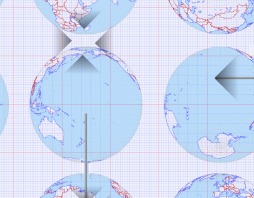| Paul Berger, Pictures |
|
WORLD INFO, 1992-94

In the realm of the material, a computer image is capable of nearly seamless collage. Its lack of inherent "surface", its existence as first and foremost a "description" of a picture, makes this so. At the same time, its ability to gather images from such an array of sources - photography, drawing, diagrammatic rendering, video, broadcast television - provides an opportunity to create highly charged composite images with multiple and even contradictory references to science, art, reportage, media. It is significant that these sources are themselves inherently collage-like.
Specifically, I am interested in the general phenomenon of "modeling", especially in the quasi-scientific variety which is best represented in the nightly television weather report. The convention of the satellite or geographic map that is presided over by a human guide, is a theater both epic and egomaniacal. I am interested in the evolving look and ideology of computer "interface", that is, the graphic appearance of the computer screen that links the general user with the sometimes complex functionality of a computer program or network, demonstrating to us mere humans that something is, in fact, going on. I am fascinated with linking the broad range of contemporary computer graphic interface conventions (icons, floating palettes, menu bars) with the older, pre-computer conventions of mechanical hand-drawing (graph-paper) and camera based imaging (photography and video). I think of this as a way to visualize something of the conflict that exists between these competing informational vehicles and the way we think of them. I use imagery of global weather and global mapping to link the two, as it represents the largest scale material referencing that we are generally familiar with.
Specifically, I am interested in the general phenomenon of "modeling", especially in the quasi-scientific variety which is best represented in the nightly television weather report. The convention of the satellite or geographic map that is presided over by a human guide, is a theater both epic and egomaniacal. I am interested in the evolving look and ideology of computer "interface", that is, the graphic appearance of the computer screen that links the general user with the sometimes complex functionality of a computer program or network, demonstrating to us mere humans that something is, in fact, going on. I am fascinated with linking the broad range of contemporary computer graphic interface conventions (icons, floating palettes, menu bars) with the older, pre-computer conventions of mechanical hand-drawing (graph-paper) and camera based imaging (photography and video). I think of this as a way to visualize something of the conflict that exists between these competing informational vehicles and the way we think of them. I use imagery of global weather and global mapping to link the two, as it represents the largest scale material referencing that we are generally familiar with.
